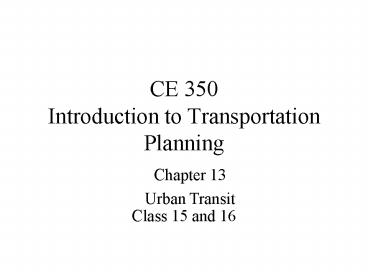CE 350 Introduction to Transportation Planning - PowerPoint PPT Presentation
1 / 9
Title:
CE 350 Introduction to Transportation Planning
Description:
Capacities of different types of transit. Relationship of ... Streetcar/light rail street or ExROW. Heavy rail (Subway, elevated or Monorail) Always ExROW ... – PowerPoint PPT presentation
Number of Views:26
Avg rating:3.0/5.0
Title: CE 350 Introduction to Transportation Planning
1
CE 350Introduction to Transportation Planning
- Class 15 and 16
Chapter 13 Urban Transit
2
Objectives
- Transit is a business
- Role of transit in urban transportation
- Types of public transit
- Capacities of different types of transit
- Relationship of transit to urban design
- Stations as activity centers
- How to plan a bus route
- How to calculate operating costs
3
Review the material associated with these tables
and figures in Chapter 13
- F 13-2 Transit mode share
- F 13-6 ROW types
- F13-20 Walking Distance
- T 13-7 productivity
- T 13-8
- T 13-11
- T 13-12
- T 13-15
- T 13-20 Land Use
- Page 476-477-478 costs
- T 13-33 Cost Allocation (Important)
4
Types of Transit and Where Each Operates
- Paratransit -- street
- Bus, articulated bus street or busway
- Low-floor bus or light rail
- Trolley bus, articulated trolley Bus street
- Bus Rapid Transit -- street or ExROW
- Streetcar/light rail street or ExROW
- Heavy rail (Subway, elevated or Monorail) Always
ExROW - Automated guideway transit-- Always ExROW
5
Terms
- Low platform stop
- High platform stop
- Cross platform transfer
- Near side bus stop
- Far side bus stop
- Self-service fare collection
- Low floor bus
6
Three Part Cost FormulaImportant--Know this
Cost AHrs BMiles C Peak buses
A, B, C are factors developed from the
transit System chart of accounts as in Figure
13-33
Hours, Miles and peak buses are developed from
route planning
7
Fleet RequirementsImportant-- Know This
Fleet Round Trip Miles Buses/hour
Miles/hr (Speed)
OR
Fleet Round Trip Miles 60 Min. /Hour
Miles/hour (speed) Headway in minutes
8
Important Concepts
- Revenue vehicle miles and hours
- Total vehicle miles and hours
- Access Relationships p.458-9
- Walking distance to stops, land densities that
will support transit
- Performance Measures
- Passengers per vehicle mile (or kilometer)
- cost per passenger
- operating ratio (ratio of revenue per passenger
to cost per passenger)
9
Emphasis
In this section, you should emphasize the various
modes of urban transit, relationship to land
uses, and routes planning. Know how to lay out
a route, estimate the annual miles and hours,
calculate the bus requirements, and estimate the
costs.































